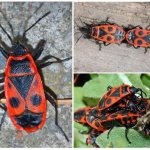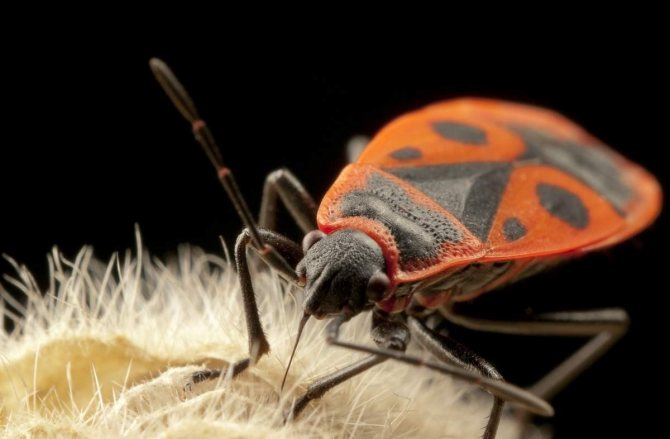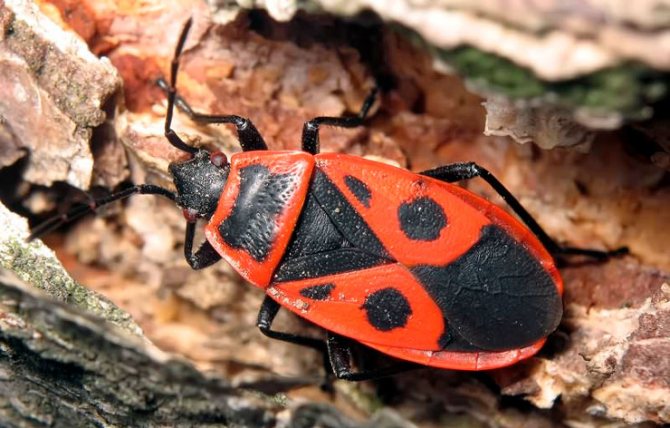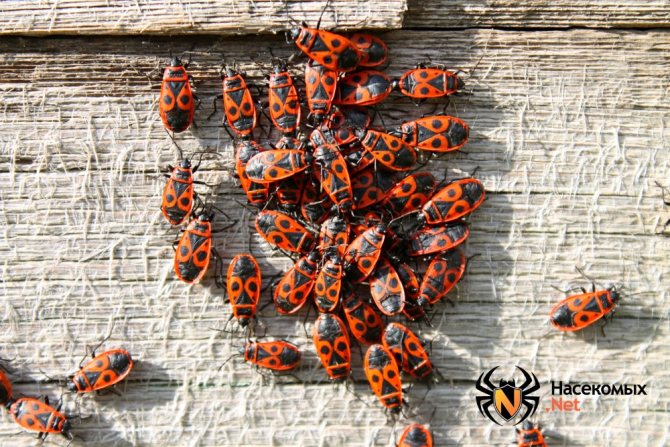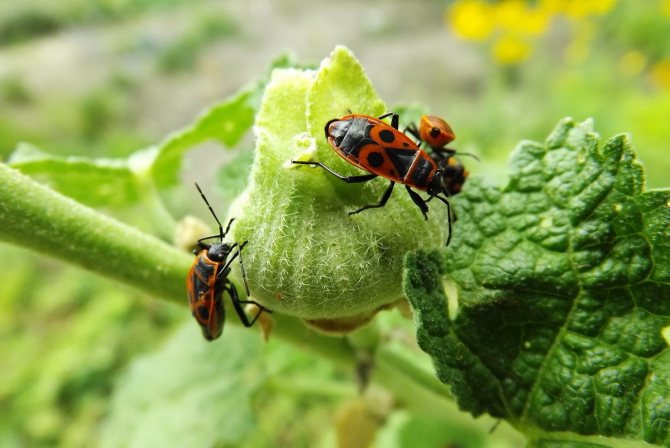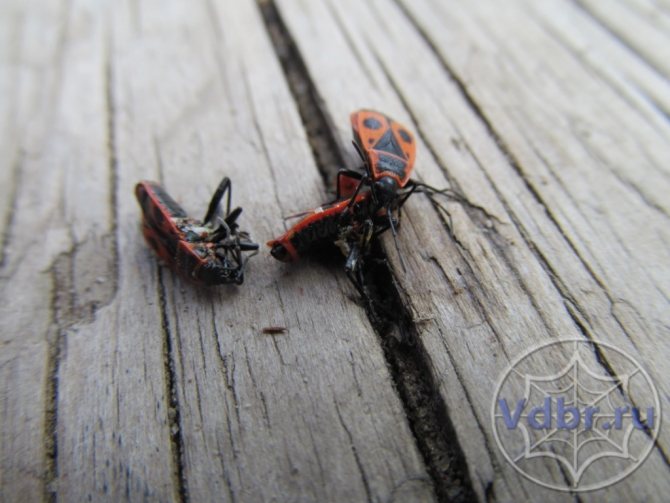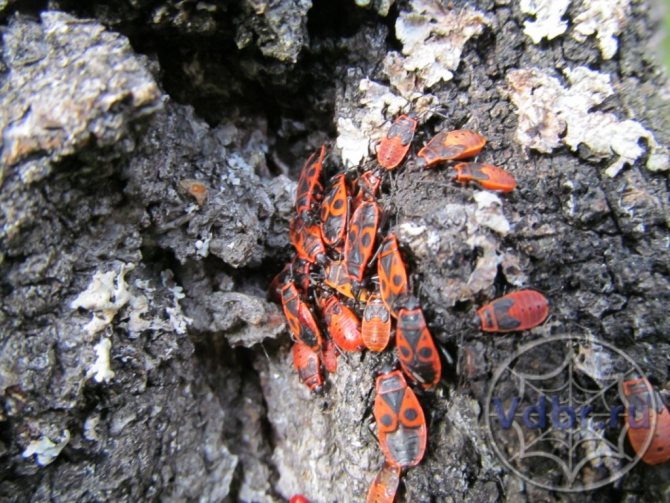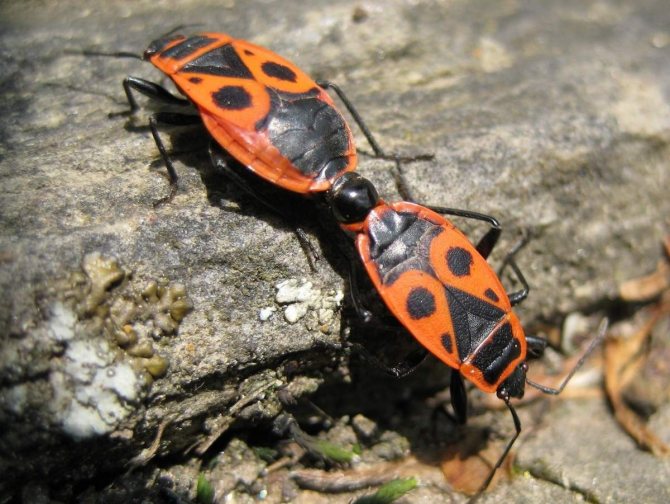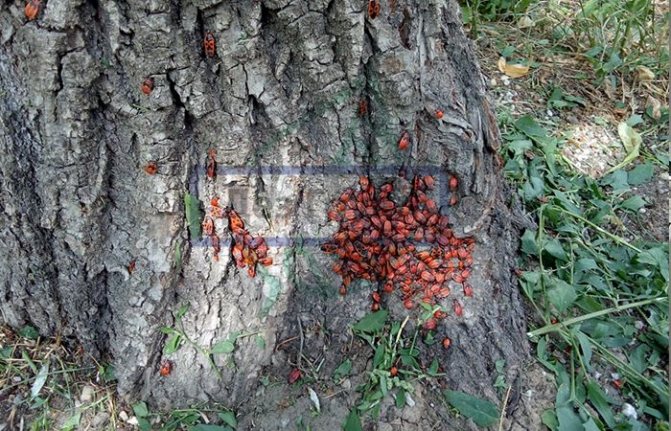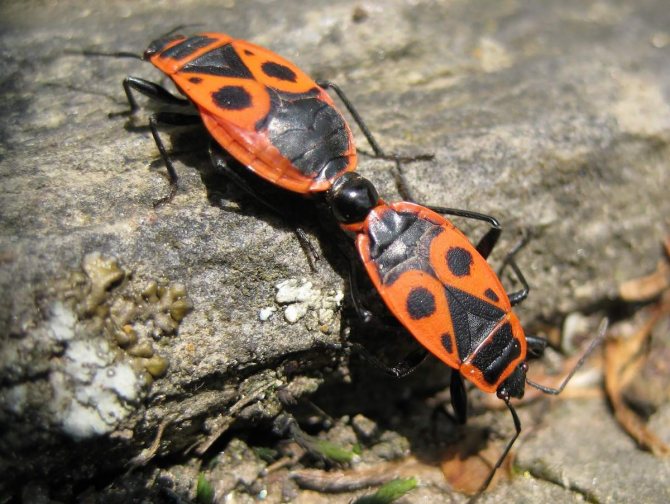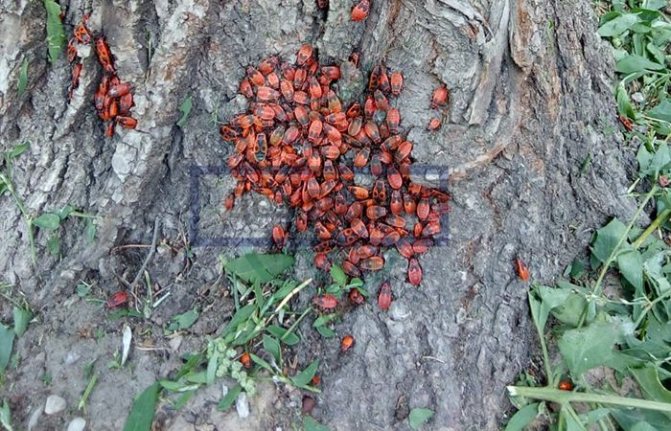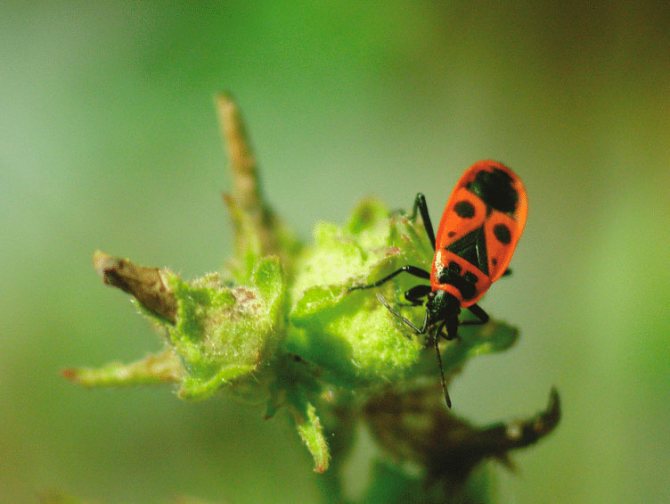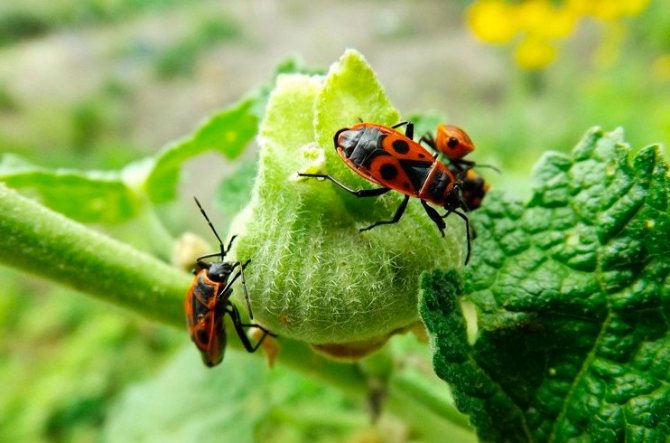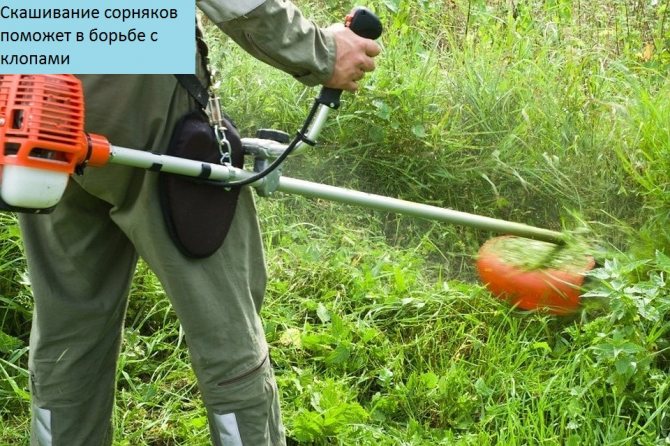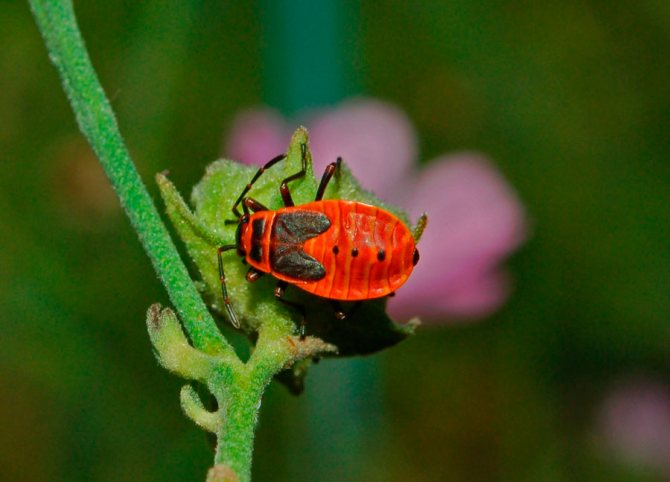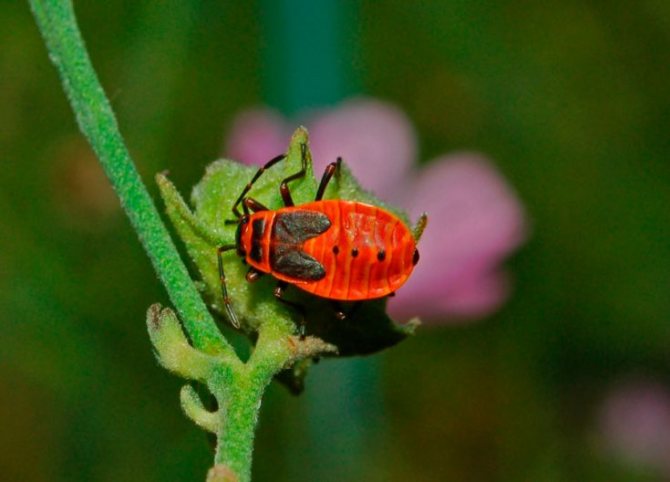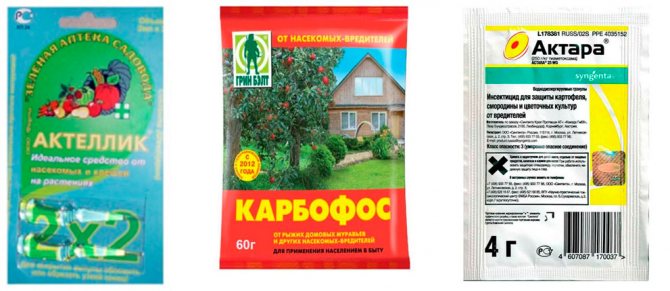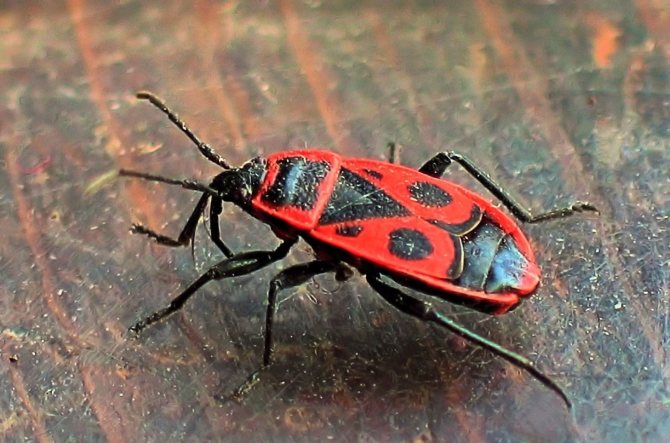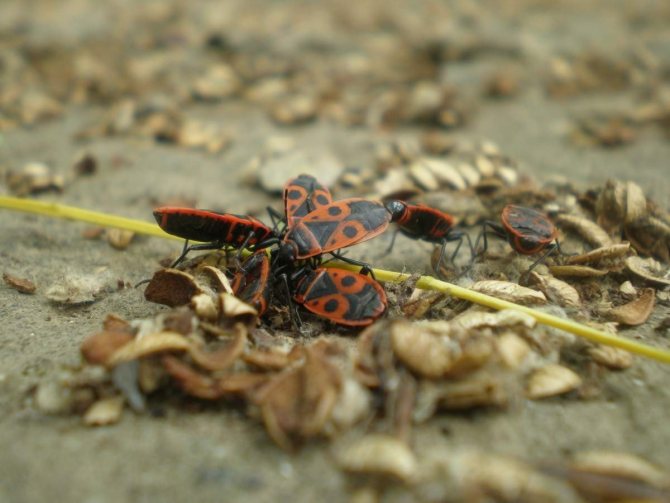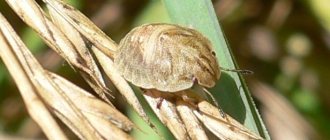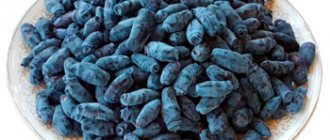Many of us have known the soldier bug since childhood. This small size and bright color of the insect can often be found in the garden. In nature, there are about 40 thousand species of bedbugs, but not all of them can boast of the original colors. Most people, admiring the colorful ornamentation on the back of a sodat, are not even aware of the amount of damage that he can cause to the owners of garden land. This article will tell you about what the soldiers' bugs are dangerous and about the methods of dealing with them.
Appearance
Description of the soldier, external characteristics, features of the body structure:
- The bright color of the soldier bug, as well as the collective way of life, makes it noticeable to others. The coloration type of the wingless redbird is unique. The oblong body is bright red. All over the surface there are patterns of black color.
- Body size is about 10 mm. Elytra are present on the back, but there are no liners. The red bug does not fly, but it crawls very quickly. Three pairs of legs have sharp claws, which allow the beetle to move on any surface in a horizontal, vertical position.
- There are small antennae on the head, which help the bug to navigate in space, to find a source of power.
The red bug has odorous glands that are activated during danger, mating season, when a power source is found. Therefore, these representatives are often called stink bugs.
On a note!
The firefighter bug is often confused with the firefighter beetle. But the last representative of the genus flies well, reaches large sizes. Otherwise, the lifestyle is similar.
The soldier bug in the photo is located below. You can examine in detail the structure of the body, the pattern on the shell. Outwardly, the bug is attractive, funny. Children fearlessly pick up an interesting creature. Even the accumulation of insects does not cause disgust, unlike other types of bugs.

Wingless redbird
Danger and benefit to humans
The benefit of these insects is that they eat decaying plants, insects and animals, thereby purifying the environment.
Soldiers are of no use to a person directly, and the harm from them may lie in the fact that they eat up the beds, which can seriously affect the entire harvest of the gardener or gardener.
Unlike bed bugs, firefighters do not bite a person, so you don't have to worry about children when they pick them up.
In order for the crop to remain unharmed, it is advisable to immediately get rid of these bugs.
Features of life
Insects live in small colonies. A mass congestion can be seen on stumps, along fences, near pots, a fallen tree. They like to warm their backs in the sun. Active in the warm season. With the onset of cold weather, they choose secluded places, climb into cracks, under mounds of leaves, branches, stumps. Hibernate. In mid-March, they wake up, crawl out. Begin to mate actively.
The mating process lasts about a week. The female connects to the male with the back of the body. In this state, the seminal fluid enters the female. A few days later, the female soldier lays eggs.
Interesting!
The place for the development of larvae chooses a leaf plate on which it feeds. Lays up to 30 eggs at a time. Round, transparent, hardly noticeable.On the sheet, they look like a tubercle, an outgrowth.
After 10 days, larvae appear from there, which differ from adults only in body size. Immediately after birth, they begin active nutrition. Sexual activity is reached after about a month of life.
Life cycle
Pests instantly multiply. The offspring of 2-3 individuals quickly fill the entire garden, causing irreparable damage to the plants. Russian latitudes with an Asian and temperate European climate are the most favorable places for redblogs.
Sexually mature soldier bugs lay eggs of pearl-gray shades. Each clutch contains 20-30 eggs. Larvae hatch from oval eggs after 1.5 weeks.
Tiny red spiders that appear with the arrival of warm spring days feed on leaves of freshly hatched weeds. As soon as cultivated plants grow, red bugs, forgetting about weeds, begin to absorb their juices.
Red beetles with black dots reproduce rather quickly, therefore, when even two or three individuals appear, one must be prepared for their mass invasion. The most favorable for living and breeding of soldier bugs is the Eurasian climate, as well as the temperate European belt. That is, the Russian latitudes are very suitable for the habitat of red bugs.
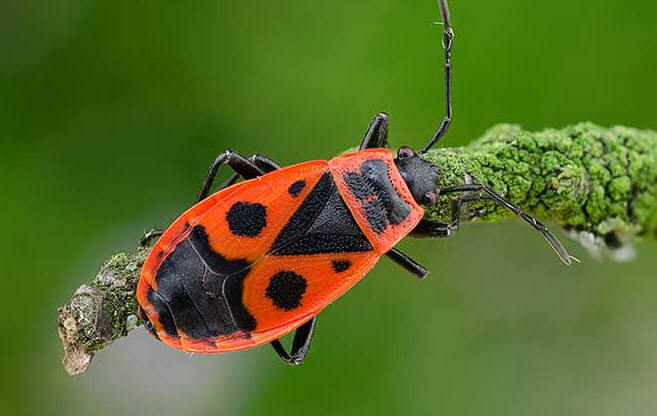

The soldier beetle lays oval pearl-white eggs. Ovipositions are more common in plants eaten by these same insects. In just one clutch, a female red beetle produces from 20 to 30 eggs, and after a week and a half, the first larvae appear from them - small red spiders. The mating process of these insects is unusual.
The larvae of soldiers' insects appear with the onset of warm spring days, and at the very beginning of their existence they eat young shoots of weeds and alfalfa. When this type of food ends, the red bugs begin to absorb the sap of cultivated vegetation.
Harm


The harm from soldier bugs
The soldier bugs feed on plant juices, the harm to humans lies in the damage to garden, vegetable garden crops. The insect cannot bite a person, the mouth apparatus does not allow, but it can scratch painfully with its claws. People take these unpleasant sensations for a bite.
The soldier begins to parasitize in early spring, when the plant is just beginning to develop:
- the suction of vital juices leads to growth retardation, leaf fall, lack of flowers;
- later, the wrecking of the bug is manifested in the impossibility of the formation of the fetus or its slowed down development.
You can determine the presence of a pest by the leaves twisted to the bottom, yellow, brown spots, tubercles in the plate.
Interesting Facts
- The mating of the soldiers occurs by connecting the back of the body of the male and female to each other. The whole process can take about 12 hours, and sometimes it takes a whole week.
- Each colony has more males than females (approximately 3-4 times).
- Once there were legends that the bites of soldier bugs are dangerous to humans and can cause irreparable harm to their health. Fortunately, this is just a fiction: these insects are harmless to humans and, in general, are not prone to aggression, bites, etc.
- The soldiers' favorite delicacy is mallow and linden seeds.
- All representatives have a very specific and very unpleasant odor. Surprisingly, even spiders, not wanting to have anything to do with them, throw these insects out of their web.
- As soon as small bugs gather together, their smell intensifies, which serves as a signal to the birds that they are inedible.
- The life of each of the representatives can last from 6 to 12 months.
- Until recently, it was believed that the soldiers feed only on fallen fruits and seeds.Some scientists are sure that some kind of mutation has occurred with them, which caused a change in their eating habits.
- They do not tolerate the neighborhood with the so-called black cohosh (cimicifuga) in every possible way. Some gardeners even note that in just a year all insects escape from such a site and find more acceptable conditions for themselves.
Control methods


Folk remedies
Removing red bed bugs can be very easy if activities are started on time. But it is advisable to fight the soldier when the site is heavily infected. You can get rid of pests in the garden mechanically, by folk remedies, in rare cases, insecticidal preparations are used.
The affected leaves are cut off, thrown away from the site, or burned. The plant itself is treated with a product prepared according to one of the folk recipes:
- Wood ash, laundry soap are added to the water. Stir thoroughly. Water the plant, paying special attention to the back of the leaves. Ash does not kill wingless redbirds, but actively scares away. The soap promotes better adhesion of active particles, covers the leaves with a protective film. Ash penetrates into the sap of the plant, makes it bitter in taste, and also causes a burning sensation when it gets on the body of an insect. It should be disposed of by spraying at intervals of 7 days.
- Red, black pepper, mustard, cinnamon, laundry soap are added to the water. Spray the plant. The tool has a deterrent effect. They will have to withdraw several times.
- Dilute green soap in water, spray. The tool has an insecticidal effect, heals wounds after numerous punctures, restores the plate.
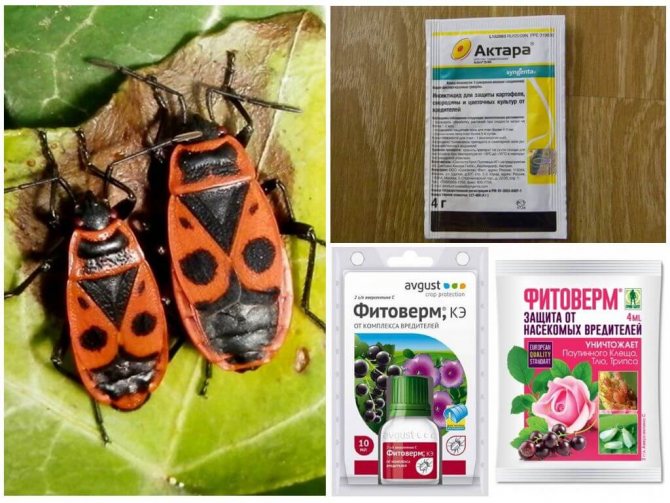

Insect repellents
How to get rid of pests in case of severe infection, use phytopreparations or insecticidal agents. Processing is allowed before flowering. Or, so that at least 20 days remain until the time of harvest.
On a note!
The drug Aktara has a combined effect. Active components accumulate in the juice and enter the insect's body through nutrition. Within an hour, the bug stops eating, dies in a day, you can destroy an entire colony in one treatment.
Phytopreparations act more slowly, but they are allowed to be used in any period of the growing season of plants. An effective tool Fitoverm. Before eating the fruit, greens should be rinsed well under running water. It will work on bedbugs within a week. Complete destruction occurs in a month with two treatments.
How to get rid of
The most effective time to get rid of these annoying insects is spring, when the crop is just preparing for planting or has recently been planted. In no case do not postpone the destruction procedure until the summer, otherwise everything that your work has been invested in will not be able to be saved.
Interesting!
Only recently have scientists proved that the soldier bug destroys garden crops, leaving them with a minimal chance of survival. Until that time, the beetle was not even registered as a pest. Everywhere it was indicated that the main food was seeds or fallen fruits.
For prophylaxis against soldiers' bedbugs:
- Given that the bug can winter in perennial legumes and alfalfa, as well as weeds, other crops should be planted away from them.
- For reinsurance, plant black cohosh (cimifuga herb) in some parts of the garden.
- Constantly monitor the mowing of the weeds to remove the eggs laid there.
- Remove all rotten wood.
If you have already allowed the appearance of a bug on the site, then be prepared for certain control procedures. To do this, use chemicals or choose folk methods.
Insecticides:
- Aktara.
- Karbofos.
- Actellic.
- Bankcol. Plants are sprayed with a solution: 7 ml per 10 liters of water.
Advice!
Be sure to read the instructions before using pesticides and follow them.
Traditional methods:
- Soap solution (take about 0.3 kg of soap and dissolve in water (10 liters), sprinkle all garden crops.
- Self-picking by hand (long and in many cases ineffective method).
- Onion peel (pour boiling water over the peel and let it brew for a day).
- Mustard (mix dry mustard with water).
- Ash (dissolve ash in water).
- Swabs with vinegar, gasoline, kerosene, turpentine or camphor oil (spread out near the places of accumulation and wait 2 days).
- Spread out freshly cut wormwood, yarrow grass.
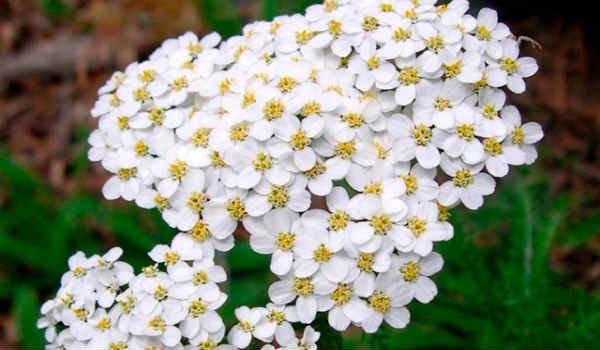

Usually, the soldier bug does not settle in people's dwellings and does not pose a danger to a person, but if you want your work on a personal plot not to be wasted, you should heed our advice on preventing the appearance of these pests and adopt methods for their destruction.
Bug soldier in the house
The human body does not seduce the pest. There is nothing in the apartment or house to attract the attention of an insect, except for indoor plants. It enters the room by mistake: through an open window, cracks in the window frame, doors, it is brought in with clothes from the garden.
It is very easy to get rid of the soldier in the house. You need to carefully throw it out the window. Even if nothing is done, the insect will not settle in a person's house. After a while, it will disappear on its own or die without finding a way out.
The harm of the soldier is not so strong as to take emergency measures, to destroy the insects mercilessly. It is recommended to use deterrent agents, harvest timely, burn leaves, minimize the number of places on the site where the redbird can overwinter.
Prevention measures
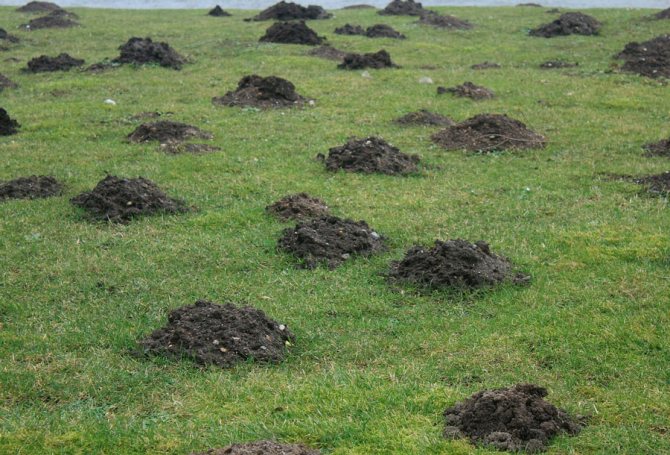

It is enough to adhere to a number of rules to prevent the invasion of soldier beetles in a personal or summer cottage. For example:
- Soldier beetles love legumes and alfalfa, so it is best to plant them in a separate area.
- Alfalfa and weeds must be mowed so that no stems remain (under the root).
- The remains of weeds, if any, are best burned.
- Do not allow rotting wood to remain on the site.
- It is better to process the trunks of fruit and berry crops with lime, and dig up the root zone well.
- You should not get carried away with excessive fertilization of the soil on the site.
The soldier beetle does not belong to the usual pests, but under certain conditions, it can harm the future harvest. Bedbugs more affect young shoots and plants, so it is advisable to take a number of actions in order to prevent the appearance of these pests on the site, and others too. There are pests from which the damage is much more serious. In any case, it is necessary to take care of the future harvest, since a lot of work is invested in it.
Where pests live
In the spaces of summer cottages, pests settle:
- in heaps of dry rubbish, building materials and stones;
- on stumps, under the bark of living trees;
- in fences, at the foundations of houses and gazebos.
In winter, they are most often found in hollows, wooden buildings, in heaps of fallen leaves and humus.
Video: where the soldier bugs live
How to understand that pests have appeared in the garden or in the garden
Alert if you notice obvious signs of insects:
- succulent plants and herbs dry up, die;
- carrot, beet tops lags behind in development, curls;
- wither, still unopened buds of roses and other flowers wither;
- in a matter of days, coriander, dill die;
- clutches of pearl-colored eggs are found, as well as small aphid-like insects.
Controlling flightless pests in large colonies is relatively easy. You just need to find the location of the nest.
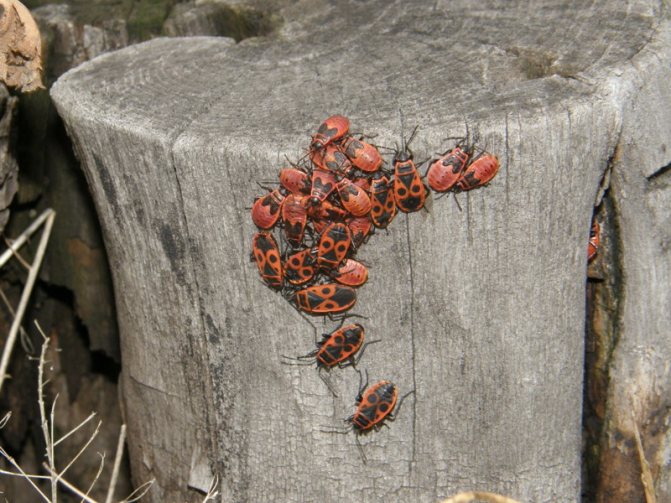

Bed bugs often create their nests in rotten stumps.

